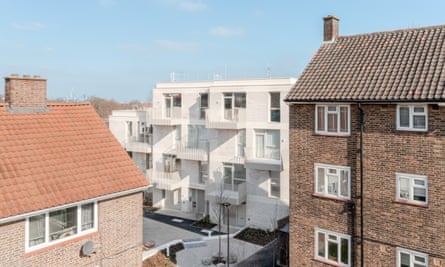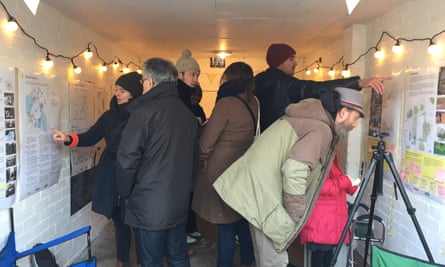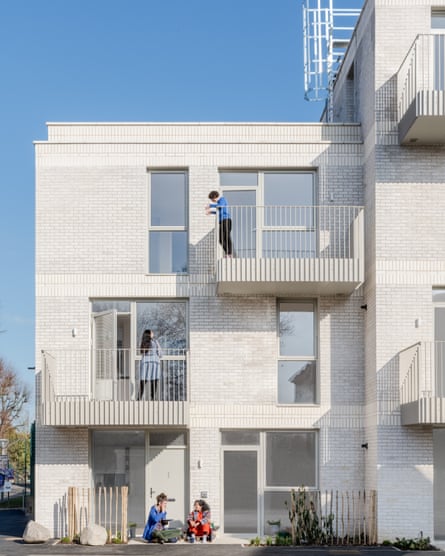In the back corner of a council estate in south London once occupied by dingy rows of lock-up garages next to a playground, there now stands a gleaming white brick block of flats. Big balconies jut out from its facade in a staggered grid, while a broad staircase loops up the back, where generous curved landings provide spots to stop and take in the view over the treetops to the skyline beyond.
At first glance, it’s a familiar sight. These must be the luxury apartments, built by a cash-strapped council in the name of “regeneration”, to help pay for improvements elsewhere on the estate. But the truth couldn’t be more different. These new homes were built by the local community, for the local community, and are sold at a price that will remain affordable to people on average local wages – for ever.

“We can’t quite believe that we’ve finally got here,” says Janet Emmanuel, assistant headteacher at the nearby Sydenham School, who started campaigning for community-led housing here 10 years ago. She is standing in one of the completed flats, which are priced at about 65% of the market value of homes in the neighbourhood, with one-beds for £215,000, and two-beds for £272,500. “For years, we had seen families priced out of the area,” she adds, “with teachers commuting from as far as Southend, and young people who didn’t qualify for social housing but couldn’t afford shared ownership. The community was being broken apart.”
Citizens House marks a watershed. After years of campaigning, plotting and planning, it is London’s first completed community land trust (CLT) created directly by local residents. Originating in the United States in the 1960s, the CLT is a radical affordable housing model that takes homes out of the property market and ties their value to the median local income in perpetuity. It is the opposite of seeing homes as investment units – as most of England does – instead conceiving the long-term stewardship of land, and the housing on it, as an asset for the community. And unlike council flats, which are still subject to the right to buy, meaning all that public investment can eventually trickle into the hands of private landlords, CLT homes will remain affordable always.
None of this makes them easy to achieve. London CLT, a non-profit organisation, has been campaigning to realise a community land trust in the capital since 2007, when the Olympic park was first identified as the site for a trial project. Like many of the 2012 Olympic “legacy” promises, it remains unfulfilled more than a decade since the games. The group was asked to prove the concept first, which they did nearby in 2016 as part of a private development, but they’re still waiting to see if a site on the hallowed legacy-scape will ever materialise.
At first, it looked like this Sydenham project might go the same way. When Emmanuel and her neighbours first approached Lewisham council with the idea for community housing, they were told there was no land. So they decided to find it themselves.
“It started one Sunday with a group of 10 of us,” she says, “roaming around, peeking over people’s fences, trying to map all the bits of leftover land in the area.” They went back to the council with their map, and began a tireless campaign, attending meetings and lobbying every official possible. “We basically made ourselves a nuisance,” she says. “We had to make them understand we weren’t going to go away, and that we wouldn’t take no for an answer.”
Their energy paid off. Backed by Lewisham Citizens, a branch of the national organising charity Citizens UK, and London CLT, the group succeeded in securing this unloved sliver of land in the corner of the Brasted Close estate. It’s a classic “infill” site, of the kind that few developers would touch and most councils would despair of. It is a good deal smaller than what they had requested, bound on all sides by other homes, overlooking a school, with poor access and a gas main running beneath, reducing the amount of area you can build on.
“It was like game of Tetris,” says Mellis Haward of Archio, the young architects that were selected to design the project by the community, after a series of public presentations. “We set up an office in one of the garages and ran a three-day workshop – not presenting designs, but really trying to understand what people wanted here.” It was not the usual tick-box “consultation”, but a true co-design process that evolved over the months and years (which the architects have recorded in a new book on collaborative community design).

“A lot of our assumptions were proven wrong,” she admits. The architects, for example, had imagined that most people would want the space in front of the flats to be a nice grassy area. “But the residents said: ‘We’ve got loads of crappy bits of grass already, and we’d actually like a big hard space where we can pull up a chair, have a barbecue, maybe use scooters and stuff.’”
Accordingly, a herringbone carpet of pale pavers now extends in front of the building, creating a broad welcome mat, dotted with boulders to stop cars from crashing into newly planted trees (and providing fun obstacles for kids to clamber on). The game of Tetris has been elegantly composed, staggering the 11 flats into three volumes so they almost read as a trio of townhouses, while pockets cut into the plan allow light into the homes from all sides. The external staircase leads to broad galleries – nearly twice the width required – creating additional sociable space outside people’s front doors, while windows bring light into the hallways, avoiding the dingy interior corridors common to most modern flats. These are subtle moves, but they make all the difference, creating a real sense of light and openness.

“It’s so different to our previous basement flat,” says Kes Gill-Martin, who works in theatre, and moved into Citizens House with his partner in January. “It was a struggle to get up in the mornings, but now I’m jumping out of bed with these lovely big windows. Being here feels amazing after 15 years stuck in the private rental trap.”
after newsletter promotion
His neighbour, Alex Ingram, a political researcher and bike charity worker, is equally enamoured. “I’d rented in London for the last 18 years,” he says, “and it was always a compromise of quality and affordability. I had been looking at shared ownership, but I couldn’t afford it with my single income alone. What really appeals to me about the community land trust model is that it’s not just a one-off – it’s a long-term affordability that carries on, and I can hand this on to someone else who needs it.”
To be eligible for one of these sought-after homes, potential residents had to meet five criteria, including having a strong five-year connection to the borough, serious housing need, involvement in their community, and sufficient income and savings to get a mortgage. Over 400 people expressed interest, and 100 completed the application, who were then interviewed by the CLT steering group, monitored by an independent panel from other housing associations.
“It was very important that anyone applying believed in the ethos of what we’re trying to do,” says Emmanuel. “We didn’t want people moving in and then just being kind of closed off.” Oliver Bulleid, director of London CLT, says that two residents of the Lewisham project have since joined the organisation’s board. “There’s a nice circularity,” he says. “You get a home, you get settled and stable, and then you contribute to the organisation, campaigning for further projects like this elsewhere.”
New housing is always contentious. But when it’s led by locals, it can help to soften any kneejerk nimbyism. As Pete Brierley, assistant director of Citizens UK, puts it: “There’s a real difference between Janet the teacher knocking on your door, and a developer or council official coming round. The local credibility gives you an opportunity to build relationships and it reduces suspicion. People are naturally worried about losing something they have, rather than gaining something better.”

There are now 350 CLT groups across the country, but it’s slow going. When I wrote about the movement in 2017, there were 225 groups, with 700 homes built and a further 3,000 in the pipeline, to be completed by 2020. Yet the total number built now stands at 2,000. A recent report launched in parliament by housing secretary Michael Gove suggested that 280,000 community-led homes could be delivered nationally – if the government bothered to help.
“The biggest issue is access to land and funding,” says Bulleid. “This government is very good at talking about community initiatives, but they are not going to renew the Community Housing Fund, which is what made this project possible.” The £2.2m cost of Citizens House was met by £1.1m from the fund, as well as the Big Issue Invest fund, and London CLT community shareholders, but the end of the national pot of money now leaves countless similar projects hanging in the balance.
Gove would do well to pay a visit to Lewisham, where a self-build CLT is also under construction nearby, to see how his funds could be better spent on community housing, rather than propping up the development industry.
“It is genuinely life-changing,” says Ingram, looking out of big sliding glass doors on to his new garden. “My only frustration is that there aren’t more places like this.”